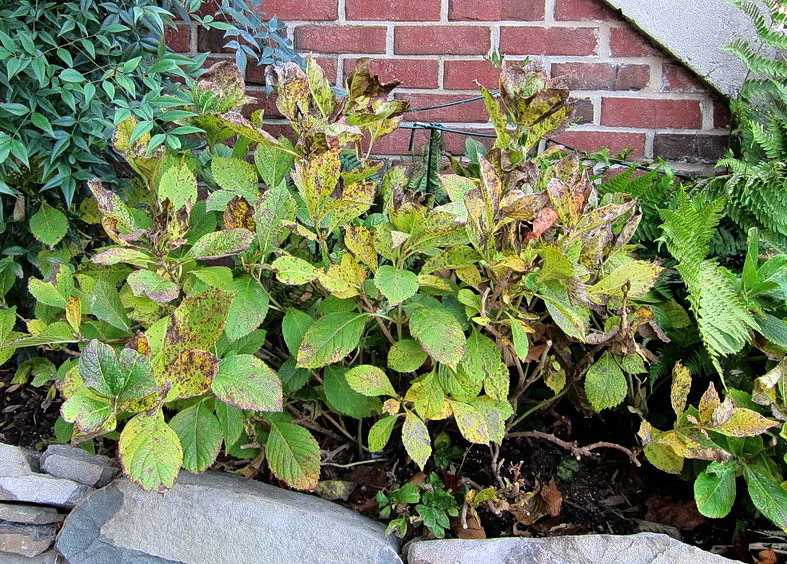The smart Trick of Hydrangea Leaves Turning Yellow That Nobody is Discussing
Table of ContentsHydrangea Leaves Turning Yellow Can Be Fun For EveryoneThings about Hydrangea Leaves Turning YellowGetting The Hydrangea Leaves Turning Yellow To WorkRumored Buzz on Hydrangea Leaves Turning YellowMore About Hydrangea Leaves Turning YellowThe Ultimate Guide To Hydrangea Leaves Turning Yellow
One opportunity is that the plant is not getting adequate sunshine. Throughout the winter season months, the days are much shorter, and the sunlight is not as intense, so see to it to place your Hydrangea in an area where it will access the very least 6 hours of sunshine every day. One more reason for Hydrangea yellow fallen leaves in winter season could be excessive water.Finally, the fallen leaves may be turning yellow due to temperature level stress. Hydrangeas like cooler temperatures, so if the plant remains in a spot that gets also warm or too cool, the leaves will transform yellow. If you believe temperature stress and anxiety could be the problem, attempt moving your Hydrangea to a various area or securing it from the aspects with a burlap wrap.

Hydrangea Leaves Turning Yellow for Dummies
In the spring when the mercury remains relatively low, they'll do fine. When things warm up over the summer season however, time spent in the very early afternoon rays can create unknown damage.: Grow your hydrangeas in a place where they'll obtain sunshine in the mornings or nights, yet not throughout the peak hours.
Wilting is triggered by absence of wetness, meaning there are a few great methods to utilize to avoid this from taking place - Hydrangea Leaves Turning Yellow. Offer your hydrangeas a healthy glug of water every couple of days when the temperature levels are climbing up high, and treat the dirt to better maintain dampness. After watering, a bit of compost around the base of each plant should assist with this by keeping moisture in the dirt

Hydrangea Leaves Turning Yellow Fundamentals Explained
As a basic guideline, we suggest removing fallen leaves when they are 50% brownish or greater. While browning brought on by any type of reason can not be reversed, taking the restorative action defined above will urge the plant to grow new fallen leaves so the harmed leaves either drop off normally or can be gotten rid of by the gardener.
Hydrangeas ought to be sprinkled just when the leading couple of inches of soil are completely dry, and should be given a complete soaking each time. Underwatered hydrangeas are most likely to have yellow, wilting, and sagging fallen leaves. Boost the frequency and amount of sprinkling for your bush to assist address this concern. Hydrangeas prefer relatively damp (yet not soggy) dirt, so give the roots a good soaking and allow water to be soaked up into the soil before applying more.
The way you deal with hydrangea leaves transforming yellow depends on the essential issue causing This Site the yellow fallen leaves. This can be hard to identify, once you this content do you will have the ability to adjust your plant treatment as necessary to take care of the issue. Hydrangea Leaves Turning Yellow. As discussed before, a typical concern with hydrangeas is vitamins and mineral deficiencies
The Main Principles Of Hydrangea Leaves Turning Yellow
Throughout the optimal expanding period, you ought to water at a price of regarding 1 inch per week. If you are fretted about not properly sprinkling your hydrangeas, there are a couple of things you can do. Including mulch to the base of the plants over the root area help to manage the temperature around the hedge and preserve water in the soil.
Conversely, you can acquire and mount easy watering globes. Watering worlds hold water in them and slowly launch this water right into the soil as the ground ends up being dry. Just fill the globe with water, stick the spout into the soil within the root area near the base of the plant, and leave it in position until all the water is gone.
If it is as well severe, some plants will never ever recover from transplant shock and will remain to decrease up until they die. Minimize transplant shock by consisting of as many origins as feasible when excavating up your plant to relocate it. Make certain to supply more water than normal in the weeks complying with planting to assist your plant recover and expand brand-new origins.
Hydrangea Leaves Turning Yellow Can Be Fun For Anyone

To stay clear of spreading out fungal conditions, make sure to thouroughly tidy and disinfect any kind of pruning devices prior to and after use. You can try to flush the roots with water to eliminate excess fertlizer.
Your hydrangea plant chooses well-drained, wet dirt. If the pot has inadequate drainage, or your dirt is swamped, the leaves will certainly begin to transform yellow.
If you do not water your hydrangea plant for even more than a week, the leaves will start transforming yellow. Fungal diseases that strike the plants have a tendency to reveal over here indications on the roots and the fallen leaves of the plant.
The Only Guide for Hydrangea Leaves Turning Yellow
Fallen leave area is an additional fungal condition that can target hydrangea. It results in the fallen leaves transforming yellow and the look of brown and purple spots on the fallen leaves.